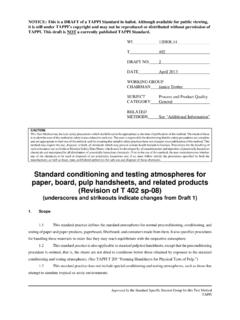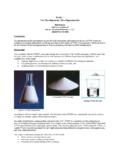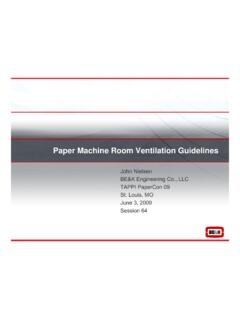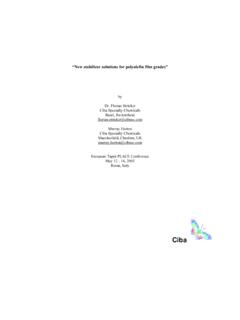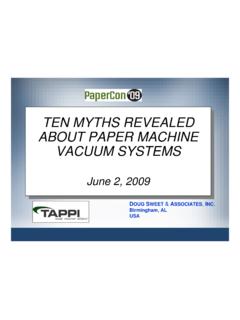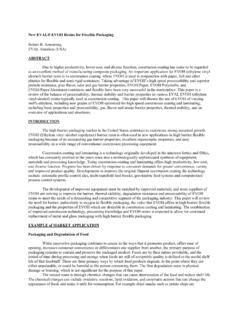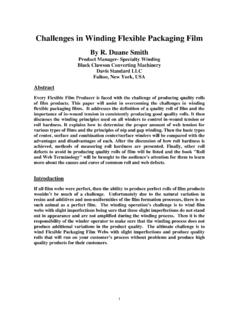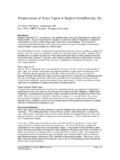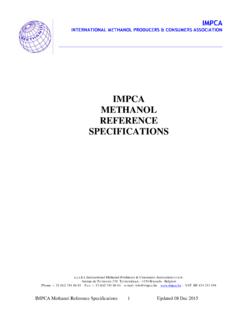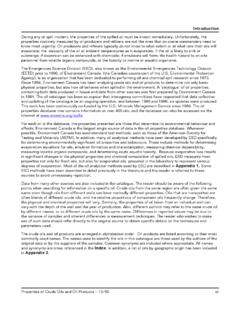Transcription of The Kraft Recovery Process - TAPPI
1 Kraft CHEMCIAL Recovery Process Honghi Tran Pulp & Paper Centre University of Toronto Toronto, Ontario, CANADA Esa K. Vakkilainnen P yry Forest Industry Oy Vantaa, FINLAND ABSTRACT The Kraft chemical Recovery Process is a mature, effective technology that provides for recycling of the pulping chemicals, efficient generation of steam and electrical power from the fuel value of the black liquor, and effective disposal of dissolved wood substances. The Process now faces significant challenges with respect to air emissions, effluent discharge, and the need for improved energy Recovery and utilization. Means for dealing with these issues are available, but they can costly. New technology may result in significant energy benefits. INTRODUCTION The Kraft Process , which uses sodium hydroxide (NaOH) and sodium sulphide (Na2S) to pulp wood, is the dominant pulping Process in the pulp and paper industry.
2 About 130 million tons/year of Kraft pulp are produced globally, accounting for two-thirds of the world s virgin pulp production and for over 90% of chemical pulp. The high strength of Kraft pulp, the ability of the Process to handle almost all species of softwood and hardwood, and the favourable economics due to high chemical Recovery efficiency (about 97%) give the Kraft Process an advantage over other pulping processes. In the Kraft Process , about half of the wood is dissolved, and together with the spent pulping chemicals, forms a liquid stream called weak black liquor (Figure 1). The weak black liquor is separated from the pulp by washing, and is sent to the Kraft Recovery system, where the inorganic pulping chemicals are recovered for reuse, while the dissolved organics are used as a fuel to make steam and power.
3 For every ton of pulp produced, the Kraft pulping Process produces about 10 tons of weak black liquor or about tons of black liquor dry solids that need to be processed through the chemical Recovery Process . This paper discusses the basic steps in the Kraft Recovery Process , problems encountered and challenges in Recovery operation, and advanced technologies that have been developed to overcome the problems. +Black LiquorWoodLigninFibreWhiteLiquor(NaOH + Na2S)Fibre+Black LiquorWoodLigninFibreWhiteLiquor(NaOH + Na2S)Fibre Figure 1. Kraft Pulping Process THE Recovery Process Figure 2 shows a simple flowsheet of the Kraft chemical Recovery Process . The Process has three main functions: i) minimizing the environmental impact of waste material (black liquor) from the pulping Process ; ii) recycling pulping chemicals, NaOH and Na2S; and iii) co-generating steam and power.
4 WoodPulpRecoveryBoilerGreenLiquorWhiteLi quorWashingWashingLimeMudLimeLime KilnCausticizingPlantWaterRecoveryBoiler HeavyBlack LiquorGreenLiquorWhiteLiquorWashingWashi ngWashingWashingWeakBlack LiquorLimeMudLimeSmeltLime KilnLime KilnCausticizingPlantCausticizingPlantWa terEvaporatorsPulpingDigesterWoodPulpRec overyBoilerGreenLiquorWhiteLiquorWashing WashingLimeMudLimeLime KilnCausticizingPlantWaterRecoveryBoiler HeavyBlack LiquorGreenLiquorWhiteLiquorWashingWashi ngWashingWashingWeakBlack LiquorLimeMudLimeSmeltLime KilnLime KilnCausticizingPlantCausticizingPlantWa terEvaporatorsEvaporatorsPulpingDigester PulpingDigester Figure 2. Kraft Recovery Process The magnitude of the Recovery Process is often not fully appreciated. Globally over billion tons per year of weak black liquor are processed; about 200 million tons per year of black liquor dry solids are burned in Recovery boilers to recover 50 million tons of cooking chemicals as Na2O, and to produce 700 million tons of high pressure steam.
5 This makes black liquor the fifth most important fuel in the world, next to coal, oil, natural gas, and gasoline [1]. Since black liquor is derived from wood, it is the most important renewable bio-fuel, particularly in Sweden and Finland. The chemical, physical and combustion properties of black liquor vary from mill to mill depending on many factors, including mill location (inland or coastal), digester , pulp yield, wood species, white liquor properties, chemicals-to-wood ratio and brownstock washing efficiency. In general, hardwood pulping requires less chemicals, has a higher pulp yield, and consequently, generates less black liquor solids than softwood pulping. Harwood black liquor generally contains less organics, tall oil and soap, and has a lower heating value (about 5% lower) than softwood black liquor. In Brazil, Chile and tropical countries, eucalyptus is the dominant wood species used in Kraft pulping.
6 Since the properties of eucalyptus black liquor are similar to those of other types of hardwood black liquor, the chemical Recovery Process in eucalyptus Kraft mills is essentially the same as others. Recovery of Pulping Chemicals, NaOH and Na2S As shown in Figure 2, weak black liquor from brown stock washers is concentrated in multi-effect evaporators and concentrators to a point where it can be effectively burned in a Recovery boiler, usually at 65% solids or higher. Concentrated black liquor is sprayed into the lower part of the Recovery boiler where it is burned in an oxygen deficient environment so that Na2S is formed. The extent of sulphide formation is measured by the reduction efficiency, typically over 90%. The inorganic sodium and sulphur are recovered as a molten smelt which consists mostly of Na2S and sodium carbonate (Na2CO3). The molten smelt enters a dissolving tank where it is dissolved in water to form green liquor.
7 The green liquor is then sent to the causticizing plant, where it is reacted with lime, CaO, to convert the Na2CO3 to NaOH. Conversion is measured by causticizing efficiency, typically 80 to 83%. The Na2S passes through the causticizing step unchanged. The causticized green liquor is known as white liquor which contains mostly NaOH and Na2S. It is returned to the digester for reuse in pulping. The precipitated CaCO3 (lime mud) from the causticizing reaction is washed, and sent to a lime kiln where it is heated to a high temperature to regenerate CaO for reuse. Recovery of Heat from Combustion of Organics The organic compounds in black liquor serve as a fuel for the production of steam which is used to generate electricity. The heat released as a result of black liquor combustion is recovered as high pressure/temperature superheated steam in the Recovery boiler.
8 The efficiency in converting the fuel value in Kraft black liquor (13,000 to 15,000 kJ/kg) to steam is typically lower than for fossil fuel combustion, because of the heat used to evaporate the water entering with the black liquor, the heat of reaction consumed in producing Na2S, and the heat carried out with the molten smelt. The amount of steam produced is typically about kg per kg black liquor solids, but can range from to about kg steam per kg black liquor solids, depending on the thermal efficiency of the Recovery boiler. The high pressure steam is passed through a steam turbine to generate electricity. Depending on the quality of the steam, and the type/ of the turbine, a 1000 t/d Kraft pulp mill can generate 25 to 35 MW of electricity by burning 1500 t/d black liquor dry solids in its Recovery boiler. The lowered pressure steam exiting from the turbine is used in various processes in the mill.
9 OPERATIONAL PROBLEMS Although the Kraft Recovery Process is straightforward in principle, it is not easy to operate at high efficiency. Many problems, both mechanical and Process , can occur. Multi-effect evaporators often experience problems with liquor side fouling, tube corrosion and foaming, particularly as the liquor becomes concentrated. These problems result in frequent evaporator boilouts, high steam consumption, and low solids in the product liquor. Recovery boilers also have many problems including fouling of heat transfer tubes and plugging of flue gas passages by fireside deposits, tube corrosion and cracking, floor tube damage, poor water circulation, smelt-water explosions, unsteady smelt run-off, high dregs in smelt, poor smelt reduction, low steam production, blackouts and air emissions. Many problems can also occur in lime kilns including: low thermal efficiency, high fuel consumption, ringing, balling, dusting, refractory and chain damage, poor lime quality and air emissions.
10 In the causticizing plant, problems often encountered are overliming, poor mud settling and washing efficiency, high sodium and low solids contents in the lime mud, low liquor causticizing efficiency, high dregs carryover and liquor-line corrosion in storage tanks. Depending on the performance of the Recovery boiler and the causticizing plant, and the amount and the way in which makeup chemicals are added into the system, the liquor cycle may have problems with non Process element accumulation, particularly chloride (Cl) and potassium (K), with high Na2CO3 and Na2SO4 deadload, and with Na and S imbalance. These operational problems result in poor pulping liquor quality, poor pulp quality, increased mill energy consumption, and decreased mill production capacity. They also make it difficult for mills to comply with increasingly stringent environmental regulations, particularly during the Process disturbance periods.
